#British GP 1991
Text
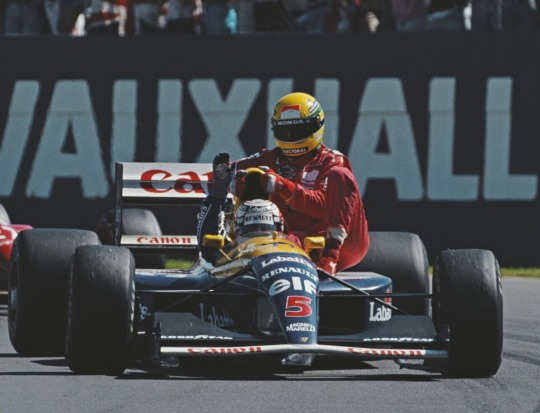
🏎️ Ayrton Senna hitches a ride on Canon Williams Team's FW14, driven by Nigel Mansell, during the British Grand Prix
📍Silverstone Circuit, England
🗓️ 14 July 1991
📸 Pascal Rondeau
13 notes
·
View notes
Text
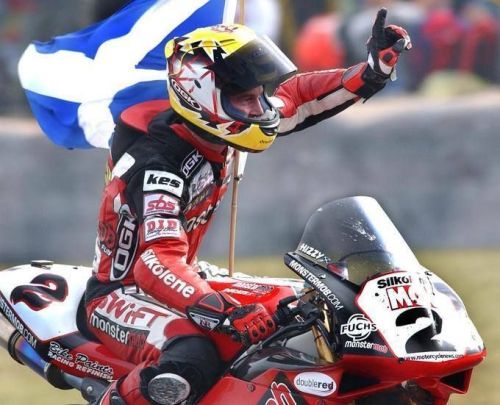
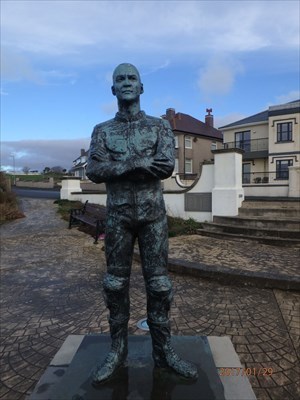

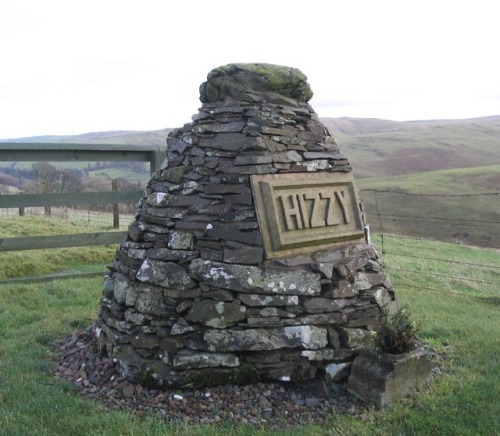
On July 30th 2003 Multi race winning Motorcyclist, Robert Steven ‘Hizzy’ Hislop died.
Hizzy, as he was affectionately known once said “If I’d never thrown my leg over a bike, I’d never have lived.”
Robert Steven Hislop grew up in the village of Chesters, near Hawick in the borders. His father started the interest of both he and his brother Garry in motorcycle racing. This was short lived at the time as he lost his father and a few years later his brother was killed at Silloth circuit. He ended up with a serious alcohol problem which led into depression.
Hizzy thankfully recovered and began his Isle of Man road racing career in 1983 by finishing second in the newcomers’ race at the Manx Grand Prix.
On short circuits, his first championship success came when he won the 250cc British Championship in 1990. Superbike victory followed with the British Superbike Championship in 1995. Some attributed his success to James Whitham leaving the series mid-season to deal with cancer.
Although he did not take a BSB victory in 1996 or 1997, Hislop was hired by Rob McElnea’s dominant Cadbury’s Boost Yamaha team for 1998. The nature of the fight for the championship between Hislop & team mate, fellow Scot. Niall Mackenzie, was illustrated by a near-collision on the last lap at Snetterton which cost the team a 1-2 finish. Hislop generally matched his countryman before a serious crash took him out of title contention.
His last championship success came in 2002 when he won the British Superbike Championship riding a Ducati. A notable feature of his season resulted from Hislop lapping Donington Park circuit more quickly on a superbike than the fastest Moto GP machine: Hislop’s modified production Ducati was heavier and less powerful than the bespoke Grand Prix bikes.
The 1992 Senior TT was described as an absolute classic. It is often described as one of the best races in TT history.
After their successful 1991 TT on all conquering Honda RVF machines, Hislop and Carl Fogarty had not planned to return in 1992. However, they both lined up on the Glencrutchery Road that year on unfancied machinery: Hislop was ona Norton with Fogarty on a Yamaha. The Norton Hizzy rode had been developed on a shoe string budget when compared with the Japanese competition. John Player had no intention of backing Steve’s TT campaign but after scratching around for some support and with minimal testing time, the team headed for the Isle of Man.
Hislop’s Norton took to the circuit in the unconventional white livery of Steve’s long term sponsor Abus. Hislop and the team defied the bike’s detractors by taking a fine 2nd place in the opening TT F1 race. The bike proved it could complete 6 laps of the gruelling Snaefell Mountain Course in hot weather so the team looked forward to Friday’s Senior TT.
Hislop’s main rival was Foggarty, who started at number 4. Steve started at 19. Not only did this give Hizzy more traffic to contend with but it also gave the crowd an anxious wait as the officials calculated the time difference between them. As the race progressed, the two riders smashed records they set the previous year with Hislop taking a narrow advantage into the final lap. In a last-ditch attempt to catch Hislop, Fogarty recorded a record lap time of more than 123 mph on his Yamaha. It was all in vain however as Hislop guided the fly splattered Norton home to an historic win. This was one of Hislop’s greatest achievements and one of the most popular TT wins. Carl Fogarty’s lap record stood for 7 years.
Hislop and Fogarty went on to become two of Britain’s most successful motorcycle racers, winning many races and championships. It was the 1992 Senior TT that saw them battle together for the last time.
Described by some as a flawed sporting genius, success in the world championships never materialised for Hislop. This was possibly because of a self-destructive aspect to his character. The flaw may have led to a number of well-publicised clashes with other riders and teams in the British championships which hindered progress into international series.
Having lost his brother and many friends in motorcycle accidents, he made a point of never going to the funerals of fellow racers, saying:
“Some people might find that a bit callous. I only ever attend family ones and people find it a bit strange that I won’t go to a friend’s funeral, but it’s just my little way of shutting off.”
Steve Hislop died in a helicopter accident in July 2003, near Teviothead, Roxburghshire and was interred in the village of Chesters near his birthplace of Hawick, Scotland. He had two children.
There is a bronze statue in memory of Hizzy in the grounds of Hawick Museum. at Wilton park and another at Onchan Head, Isle of Man, as seen in order in the pics. The last pic is a cairn near Teviothead, the scene of the helicopter crash, it reads……
‘Hizzy’
This cairn was built by a
few friends of Steve Hislop,
British Superbike Champion,
who was tragically killed in a
helicopter accident near this site,
on July 30th 2003.
Kind permission was granted
by His Grace
The Duke of Buccleuch.
28 notes
·
View notes
Text


Happy birthday DAMON HILL!!!!!!!!!!!! (17/09/1960) ⚡
“I have always liked a challenge.”
Damon Graham Devereux Hill was born in Hampstead, he was the son of Bette, former rower and medalist at the European Rowing Championship, and the note Graham Hill, two time Formula 1 world champion in the 60s; he also has two sisters: Samantha and Brigitte. Since the day he was born, he had a comfortable life and was immeresed in the world of motoracing: often, he's pictured in F1 paddocks as he observes his father with wonder, while he fixes his helmet, or shares a few words with fellows racing drivers, like Jim Clark; his future seemed already written. But after Graham's sudden passing in 1975, Damon and his family, in addition to the sudden shock and change, they were left in drastically reduced circumstances, forcing 15 year old Damon to start working first as a labourer and later as a motorcycle courier to support his family and education, and later motoracing career.
It was in the early 80s, that Damon started racing on motorcycles. At first seen as a way to earn money, later it'll become a serious matter, as he soon started to score victory after victory. In 1984 he even ended up winning the 350cc Clubman's Championship at Brands Hatch. However, Bette was quite concerned about the risks of the sport, successfully persuading Damon to switch from two-wheel racing to four and to take a racing car course at the Winfield Racing School in France. Since in 1984 he was still busy racing on motorcycles, he sporadically took part in single-seaters competitions, but the following year he commited to four wheel racing and took part in the British Formula Ford, and later moved up into Formula 3. Unfortunately, during his three years in F3 he changed teams quite often, but managed to score some important wins that would grant him good positions in the championships. In 1989, although he lacked funds, Damon progressed to Formula 3000, which unfortunately will result in an adverse experience, since he never managed to win one race, despite taking the pole several times.
While still racing in the Formula 3000, in 1991, he got the chance to become a test driver for the successful Williams team and will later join the Brabham team to replace Giovanna Amati, making his official F1 debut at the '92 Spanish Grand Prix; but one thing about Brabham is that, at the time, it was a 'dying' team and the pace of the car was just awful, so awful that Damon often did't even manage to qualify for the race; but his talent sparked, despite having an uncompetitive car, like at Silverstone, where he managed to qualify in one attempt, and in Hungary, where he finished 11th after starting from the 25th position. It was after the latter, that the Brabham team left Formula 1, due to their on going financial difficulties, meaning that Damon wouldn't be able to finish his first F1 season. But the future seemed bright: he signed with Williams, and joined in the team the 3 time, soon-to-be four, world champion Alain Prost. In his first 'official' season Damon immidiately showed what he was capable of with the right car: he took his first grand prix victory in Hungary, after leading from start to finish the race, and it was followed by two more victories, one at Spa and the other at Monza. His third win secured Williams the Constructors championship. From one world champion to the other, Damon was joined in the team by Ayrton Senna for the 1994 season, which turned out to be an unpleasant one: first came Ayrton's fatal accident at Imola, that left Damon as lead driver, and later in the season came the controversial collision with Michael Schumacher at the Australian GP, where both drivers were contenders for the World Championship. The following season was heated up by the frequent on track battles between him and the German, after the bitter ending of the previous season, but all in all the season ended up in a positive way, as he took the second place in the Champioship, exactly like the previous year. But the 1996 season seemed the one: the car was the quickest on the grid, he got along pretty well with teammate Jacques Villeneuve, he never qualified off the front row and won 8 races of 16. Finally Damon became World Champion.
After his big success, Damon felt it was time to leave Williams, and joined Arrows, a team that never had a real chance of winning in its 20 year history, and remained like that, despite Damon's 2nd place in Hungary. But overall it was quite an unsuccessful season for the Brit. However things didn't get better as he joined the Jordan team: through out the two seasons spent with the irish team he got a lot of retirements, but managed to finish in the points and even got his last victory at the '98 Belgian GP. After such an unsuccessful season, that saw a few mechanical changes, Damon decided to retire from Formula 1.
Despite leaving the F1 in '99, Damon stayed, and still is, very much involved with the sport, like appearing in tv programmes or as a commentator for sky.
Since an early age Damon was interested in music and learned how to play the guitar, also in his teenage years, he formed a punk band with some of his school friends called "Hormones".
Since his debut in motorcycle racing, Damon's helmet design has always been the same as his father's: eight white oar blades arranged vertically around the upper surface of a dark blue helmet.
Damon was the first son of a Formula 1 Champion who in turn became one as well. The second one is Nico Rosberg.
#haaaaaaappy bdaaay damon!!!!!!#I excepted to write less honestly lmao#damon hill#classic f1#f1#formula 1#retro f1#f1_bdays
20 notes
·
View notes
Text
Events 1.17 (after 1945)
1945 – World War II: The Vistula–Oder Offensive forces German troops out of Warsaw.
1945 – The SS-Totenkopfverbände begin the evacuation of the Auschwitz concentration camp as the Red Army closes in.
1945 – Swedish diplomat Raoul Wallenberg is taken into Soviet custody while in Hungary; he is never publicly seen again.
1946 – The UN Security Council holds its first session.
1948 – The Renville Agreement between the Netherlands and Indonesia is ratified.
1950 – The Great Brink's Robbery: Eleven thieves steal more than $2 million from an armored car company's offices in Boston.
1950 – United Nations Security Council Resolution 79 relating to arms control is adopted.
1961 – U.S. President Dwight D. Eisenhower delivers a televised farewell address to the nation three days before leaving office, in which he warns against the accumulation of power by the "military–industrial complex" as well as the dangers of massive spending, especially deficit spending.
1961 – Former Congolese Prime Minister Patrice Lumumba is murdered in circumstances suggesting the support and complicity of the governments of Belgium and the United States.
1966 – Palomares incident: A B-52 bomber collides with a KC-135 Stratotanker over Spain, killing seven airmen, and dropping three 70-kiloton nuclear bombs near the town of Palomares and another one into the sea.
1969 – Black Panther Party members Bunchy Carter and John Huggins are killed during a meeting in Campbell Hall on the campus of UCLA.
1977 – Capital punishment in the United States resumes after a ten-year hiatus, as convicted murderer Gary Gilmore is executed by firing squad in Utah.
1981 – President of the Philippines Ferdinand Marcos lifts martial law eight years and five months after declaring it.
1991 – Gulf War: Operation Desert Storm begins early in the morning as aircraft strike positions across Iraq, it is also the first major combat sortie for the F-117. LCDR Scott Speicher's F/A-18C Hornet from VFA-81 is shot down by a Mig-25 and is the first American casualty of the War. Iraq fires eight Scud missiles into Israel in an unsuccessful bid to provoke Israeli retaliation.
1991 – Crown Prince Harald of Norway becomes King Harald V, following the death of his father, King Olav V.
1992 – During a visit to South Korea, Japanese Prime Minister Kiichi Miyazawa apologizes for forcing Korean women into sexual slavery during World War II.
1994 – The 6.7 Mw Northridge earthquake shakes the Greater Los Angeles Area with a maximum Mercalli intensity of IX (Violent), leaving 57 people dead and more than 8,700 injured.
1995 – The 6.9 Mw Great Hanshin earthquake shakes the southern Hyōgo Prefecture with a maximum Shindo of VII, leaving 5,502–6,434 people dead, and 251,301–310,000 displaced.
1996 – The Czech Republic applies for membership in the European Union.
1997 – Cape Canaveral Air Force Station: A Delta II carrying the GPS IIR-1 satellite explodes 13 seconds after launch, dropping 250 tons of burning rocket remains around the launch pad.
1998 – Clinton–Lewinsky scandal: Matt Drudge breaks the story of the Bill Clinton–Monica Lewinsky affair on his Drudge Report website.
2002 – Mount Nyiragongo erupts in the Democratic Republic of the Congo, displacing an estimated 400,000 people.
2007 – The Doomsday Clock is set to five minutes to midnight in response to North Korea's nuclear testing.
2008 – British Airways Flight 38 crashes short of the runway at Heathrow Airport, injuring 47.
2010 – Rioting begins between Muslim and Christian groups in Jos, Nigeria, results in at least 200 deaths.
2013 – Former cyclist Lance Armstrong confesses to his doping in an airing of Oprah's Next Chapter.
2013 – Shahzad Luqman is murdered by members of Golden Dawn in Petralona, Athens, leading the creation of new measures to combat race-based attacks in Greece.
2016 – President Barack Obama announces the Joint Comprehensive Plan of Action.
2017 – The search for Malaysia Airlines Flight 370 is announced to be suspended.
2023 – An avalanche strikes Nyingchi, Tibet, killing 28 people.
0 notes
Text
Dr Greg's No Diet-diet Program And Products 5, Sandton, 2191
Together they have set a high normal of serious scholarship within the examine of architectural historical past in Johannesburg. In 1991, Mokgatle joined Eskom as a senior authorized adviser and moved up the ranks to be the first black particular person and first lady appointed as MD of the utility's transmission group, which she turned from lossmaking to worthwhile inside a year. She was involved with the restructuring of the Electricity Distribution Industry and chaired the board of the Holding Company. She has additionally been concerned in Energy Regulation in South Africa and was Deputy Chairperson of the Board of the National Energy Regulator. From 2003 to 2005 she was CEO of state rail parastatal Spoornet, now Transnet Freight Rail. The US president on the time, Ronald Reagan, came underneath fire for ignoring the rising AIDS crisis and when he finally addressed the epidemic — in 1987 — nearly 23,000 individuals had died of the disease.
He met and married Mary Chambers in England, and dedicated the following fifty two years to caring for her - she was wheelchair-bound having being identified early in their relationship with a quantity of sclerosis. Ironically, Lonsdale himself suffered a stroke in 2010, which confined him to a wheelchair. His wife survives him, as do his two daughters and 6 grandchildren. Former Senior Lecturer in Physiology at Wits, Professor Ralph Ernest Bernstein died on 19 October 2013, aged 99. He held BSc (1934), BSc Hons (1936) and MSc (1937) levels, and an MBBCh (Cum Laude) (1940) from Wits.
He labored part-time at University of Wisconsin and again on the University of Massachusetts, Amherst, where he accomplished a master’s in mechanical engineering. His marriage fell aside at this stage and Lance went to his grandparents in Italy to be raised as an actual Italian American. Dr Mankowski didn’t shine academically and left school a little bit of a dropout. He had a four-year spell at Fort Ord in the army (where he volunteered). There he met one or two mature younger males who inspired him to suppose about studying additional and an African American instructor who impressed in him a love of maths.
She hosted countless University features during Ellison’s tenure as Dean and as Deputy Vice-Chancellor. She tirelessly provided editorial assistance during her husband’s 50-odd years as editor of the South African Law Journal. A stalwart of the Jewish neighborhood, Lissoos was a founding member of the Victory Park Synagogue and previously served the King David Schools and Jewish Board of Education. He lectured and wrote on subjects of Jewish and common historical curiosity and delivered the keynote tackle at the opening of the South African Jewish Board of Deputies “Jewish Johannesburg 120” exhibition in 2007. Amongst a number of papers which he wrote and offered, was one within the South African Medical Journal in May 1963.
In 1963 he went to work for General Electric finally moving to British Rail the place he rose to the rank of Assistant Chief Mechanical Engineer primarily based in Derby. He later joined Brush where he remained till his retirement in 1991. Dr George St Ledger Warren (MBBCh 1942, Master of Surgery 1955) died in Parkmore, Gauteng in 2007, aged 91. Born in Johannesburg, Warren matriculated from Jeppe Boys High and studied medication at Wits, where he was president of the Students Representative Council, the Students Medical Council and a founding member of the squash club. He served as a medical officer in Italy during WWII and joined Anglo American as a medic thereafter. It was while working as a GP in South West Africa (Namibia) that he got interested in the emotional issues encountered generally practice.
In 2004, he established Voiceless, an animal rights advocacy organisation, with his daughter Ondine. He was also a connoisseur of fantastic food and wine and cultivated friendships with many people who served him at their well-appointed tables. He also took a lot delight in the reality that he saw himself as the Austin household historian.
In 2013 he was awarded a Gold Medal for his contribution to the university and community of Azaadville. In 1955, Dr Uys left for England together with his new bride Midge, a midwife. He spent three years at St Mary's in Manchester, and in the Canterbury and Isle of Thanet Group in Kent. He gained his MRCOG in 1958, and accomplished his coaching at King Edward VIII Hospital in Durban.
Unlike his three brothers who joined their legendary father, Archie, in stockbroking, Ian chose to go into regulation. He joined I Mendelow and Browde in 1977, changing into a partner in 1981, and remained with the agency in its numerous guises until he joined Fluxmans in 2012. Nisbet grew to become a consulting engineer of the Anglo American Corporation in 1972, and a deputy managing director of the Gold Division in 1974. He joined JCI in October 1980, and was appointed an executive director in 1981 and chairman and managing director of its Gold and Uranium Division in January 1982. He was described as “a humble man of science and historical past, a trainer, a philosopher and a devoted husband and father”. Dr Beorn Cloete Uys (MBBCh 1952) was born in Amersfoort initially of the Great Depression.
He moved freely in, and made contributions to circles the place the only value of entry was excellence and intelligence. Ramquar Ramasar was a life member of the South African Medical Association (SAMA). He recalled that at the first ever medical affiliation meeting that he attended, he, having sat within the entrance row, was advised throughout a break that he could not do so, and needed to have his tea in a separate room on the grounds of his race. He acquired the Dr KM Seedat Fellowship Award for long and dedicated service from the Family Practice Association in 1996. In his skilled capability he served as honorary medical advisor to the Natal Blind and Deaf Society and the Friends of the Sick Association (FOSA), an organization devoted to the care of sufferers with tuberculosis. He was additionally President of the Umzinto and Districts Indian Child Welfare Society.
Dr Gregory Facebook
This research proved to be the seminal work of his career, demonstrating the necessity to manage such fisheries on a multispecies foundation. He taught fisheries biology on the University of Papua New Guinea and started research into big clam progress rates. His analysis in this area contributed towards main aquaculture and re-stocking programmes of those near-extinct species. Dr Gonasilan Chetty (MBBCh 1992) died of a coronary heart attack on 10 August 2009, aged forty. Born on 26 April 1969, the previous Eastern Cape physician was a successful specialist in Johannesburg.
#Dr Gregory Hough South Africa#Dr Greg Hough South Africa#Dr Gregory#Dr Greg Hough#Greg Hough#Dr Gregory Hough#Dr Gregory Images#Dr Greg Hough Images#Dr Gregory Facebook#Dr Greg Hough Facebook
1 note
·
View note
Text
#7 - Hanging Rock State Park - 5/6/2023
Stokes County / 1790 Hanging Rock Park Road, Danbury, NC 27016/ GPS: 36.4119, -80.2541 ..... PARK MAP
Fast Facts: 30 miles north of Winston Salem, this 9,011-acre state park is slightly west of Danbury NC, the county seat of Stokes County. It's located in the Sauratown Mountain range made up of monadnocks that are separated by the nearby Blue Ridge Mountains. The highest point in this state park as well as the aforementioned range is Moore's Knob which rises to 2,759 feet above sea level. In 1936, the first 3,096 acres were donated to establish the park. Additional land acquisitions in the 1970s added the Lower Cascades and the infamous Tory's Den, a rock outcropping rumored to hide British Loyalists during the Revolutionary War. A final land acquisition in 2000 added the Flat Shoals Mountain. The Hanging Rock State Park Bathhouse was added to the National Register of Historic places in 1991.
Trail(s): Moores Wall Loop Trail - 4.86 miles / 2:20:31 - AllTrails + Strava
Hike Buddies: Dave Townsend
Hike Conditions: sunny, mid 50s at the start.
Comments: Located about 97 miles from the house, it took us about 1 hour 30 min to get there. I picked Dave up just after 7a and we were on the trail just after 8:30a. Dave purposely carried a heavy pack as he was/is in training for a massive 4-day, 54 mile hike in Glacier National Park this coming August with daughter Annabelle. Our hike started behind the stone bathhouse next to the lake parking lot and we opted to go left (clockwise) which elongated the elevation gain but made it more manageable. The first part of the loop was compact and carved through dense patches of rhododendron which helped shape the trail. This was pretty neat. About 1.5 miles into the hike, the terrain turned very rocky as we started making our ascent to Moores Knob. We went off path once or twice making it a little more interesting, but quickly found our way back to the trail. Somewhere between mile 2.5 and 3 we reached the pinnacle and climbed up Lookout Tower, a former fire tower where we were treated to a 360-degree panoramic view of the surrounding areas (Dan River basin and Virginia to the North, Winston Salem to the South, Hanging Rock Mountain and Greensboro to the East and Pilot Mountain, Elk Knob, Grandfather Mountain and Mount Mitchell (120 mi) to the West - picture 4). We took in the scenery for a bit before leaving and descending the 684 stone steps of the “endless staircase.” We were off the trail and back to our car shortly before 11:30. We finished with lunch at River Rock Cafe in Danbury before making the return trip home.





0 notes
Photo



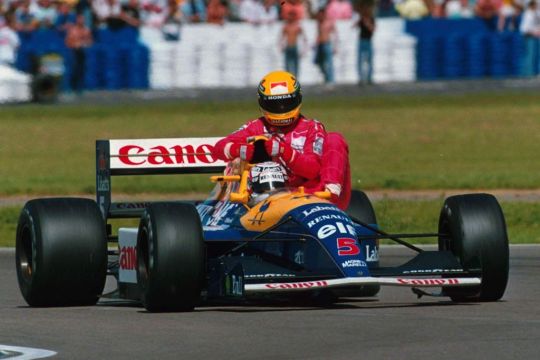
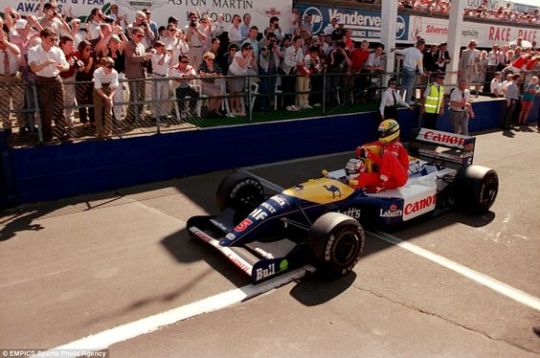
Iconic F1 moments: Nigel Mansell gives Ayrton Senna a lift back to the pits. British GP, Silverstone, 1991.
#ayrton senna#nigel mansell#f1#formula 1#sports#motorsport#autosport#photos#photography#british gp#silverstone gp#1991#the 90s#iconic#legends#inspiration#legendary#sennasempre#williams#maclaren#cars#beautiful
12 notes
·
View notes
Text
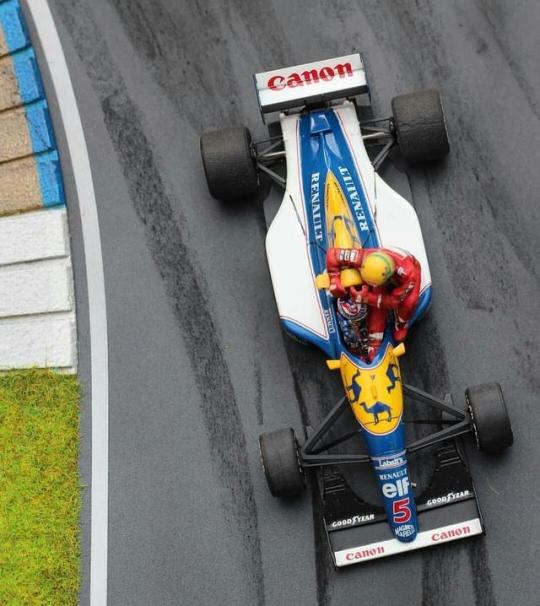
Ayrton Senna getting a lift from Nigel Mansell at the 1991 British GP
68 notes
·
View notes
Text
McLaren team-mates Daniel Ricciardo and Lando Norris will drive Ayrton Senna’s most iconic cars at FOS

Ricciardo and Norris will share Ayrton Senna’s 1988 McLaren MP4/4, 1990 MP4/5 and 1991 MP4/6 Championship-winning machines over the Festival of Speed, which will take place on the weekend of the 8th–11th July. They will arrive fresh from the Austrian GP and ahead of the British Grand Prix at Silverstone, the 10th of the season’s 23 races.
#shout Zak or Andreas or Mclaren Auto or whichever magician made this happen#YOU KNOW DANIEL IS DYING#f1#daniel ricciardo#lando norris#mclaren#Ayrton Senna
143 notes
·
View notes
Text
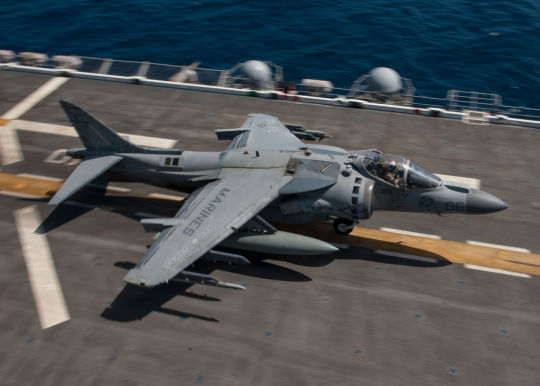
-An AV-8B from VMA-163 takes-off from USS Makin Island (LHD-8). | Photo: National Museum of the U.S. Navy
Flightline: 70 - McDonnell Douglas/BAe AV-8B Harrier II
The AV-8A was operated by the USMC beginning in 1971, but the Marines quickly found that the Harrier was less powerful than hoped, only capable (with a standar takeoff, no less) of carrying a smaller payload than an A-4 over a shorter range. In 1973, a joint US/UK team began work on a project to develop a new Harrier, powered by a redesigned Pegasus 15 engine. This aircraft, dubbed the AV-16, would have double the AV-8A’s range and payload, and would replace the Harrier GR.1/3 in RAF service and the AV-8A and A-4 Skyhawk in USMC roles. The UK pulled out of the project in 1975, owing to rising costs and decreased defense spending, and the US, unwilling to foot the costs alone, canceled the program. McDonnell Douglas and Hawker Siddeley continued work on upgrading the Harrier, and in 1976 began modifying two AV-8As with new wings, revised intakes and nozzles, and other aerodynamic changes. These mules were designated YAV-8B.

-One of two AV-8As being modified into YAV-8Bs. | Photo: U.S. Navy Naval Aviation News
The results showed greater than expected drag, but positive test results in other areas, including payload, range, and V/STOL performance, led to the award of a development contract in 1979. In 1981 BAe (formed by the nationalization and merger of British Aircraft Corporation, Hawker Siddeley Aviation, Hawker Siddeley Dynamics and Scottish Aviation) rejoined the program in 1981, enticed by the more affordable path McDonnell Douglas was forging. The MoU stipulated a 60/40 split between the US and UK companies, with airframe production taking place at McDonnell Douglas’ facilities in suburban St. Louis, Missouri, and BAe’s Kingston and Dunsfold facilities, and engine production split 75/25 between Rolls-Royce (which had previously absorbed Bristol Siddeley) and P&W.

-Illustration: McDonnell Douglas
The AV-8B Harrier II was extensively redesigned from the AV-8A, with the forward fuselage extended and the cockpit raised by ten inches, providing better pilot visibility. To compensate for these changes, the rear fuselage was lengthened by a foot and a half, and a taller tail, based on that used on the Sea Harrier, was fitted. The biggest change was the new supercritical wing, which was larger than the one used on previous models (the outriggers on the AV-8B are in the same place as on the AV-8A/GR.1/3, giving a sense of scale), and had a higher aspect ratio and decreased sweep. The new wing also had leading edge extensions, all of which grants the Harrier II a 6,700lb increase in payload with a 1,000' takeoff roll. The AV-8B was the first combat aircraft to feature carbon fiber composites in its construction, with the wing and forward fuselage being almost exclusively carbon/epoxy construction, leading to the Harrier II being almost five hundred pounds lighter than if it had been constructed from metals alone.

-An AV-8B from VMA-331 in 1991 during Operation DESERT STORM. The squadron eventually dropped 256 tons of ordinance during the war and became the first attack squadron to operate from an amphibious assault ship. | Photo: U.S. Navy National Museum of Naval Aviation
The AV-8B completed operational evaluation (OPEVAL) in 1985, and entered service with the USMC starting with USMC squadron VMA-331 (“Bumblebees”). In 1990 Marine Harrier IIs were deployed to the Persian Gulf on the amphibious assault ships USS Nassau and Tarawa as part of Operation DESERT SHIELD, flying training and support sorties. Despite plans to hold the AV-8B in reserve during the initial phases of DESERT STORM, Harriers were pressed into service on 17 January in response to a call for close air support from an USMC OV-10 Bronco against Iraqi artillery positions. The next day, AV-8s began strike missions against Iraqi targets in southern Kuwait. During Operations DESERT SHIELD and DESERT STORM, 86 AV-8Bs amassed 3,380 flights and about 4,100 flight hours, with a mission availability rate of over 90 percent. Five AV-8Bs were lost to enemy surface-to-air missiles, and two USMC pilots were killed. After the end of the war, Norman Schwarzkopf included the AV-8 along with the F-117 and AH-64 in his list of weapons that played crucial roles in the campaign. Marine Harriers remained in the Gulf region during Operation SOUTHERN WATCH from 1992 to 2003, operating from ‘phibs in the Gulf and from forward operating bases such as Ali Al Salem Air Base, Kuwait. Marine Corps Harrier IIs were later flown during Operation ALLIED FORCE over Yugoslavia, ENDURING FREEDOM in Afghanistan, and the 2003 Iraq war.

-An AV-8B Harrier aircraft hovers above the flight deck of the amphibious assault ship USS Bataan (LHD 5) as the pilot makes a vertical landing. The Bataan was dubbed “Harrier Carrier” during Operation Iraqi Freedom. | Photo: Photographer’s Mate 3rd Class Jonathan Carmichael - USN
Two major variants of the AV-8B were produced: the Night Attack Harrier and the Harrier II Plus. First fielded in 1991, the Night Attack Harrier featured a FLIR camera on the nose cone, a wide-angle HUD, provisions for NVGs and a digital moving map. The Night Attack Harriers are powered by a Pegasus 11-61 (aka the F402-RR-408), which produce 23,000lbf of thrust. The Harrier II+ is also powered by the -408, and is fitted with a APG-65 multi-mode pulse-Doppler radar, taken from early model F/A-18s during their own upgrades to APG-73 radar. This allowed Harrier II+ to carry AIM-120 AMRAAM, as well as AGM-65 Maverick and AGM-84 Harpoon missiles, though the angle-rate bombing system was removed. Upgraded AV-8Bs are also capable of carrying a LITENING targeting pod, allowing the employment of PGMs.

-An AV-8B Night Attack Harrier, showing the FLIR camera mount on the nose. | Photo: Dick Wels
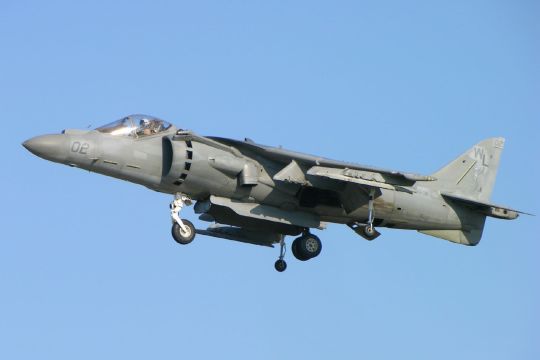
-An AV-8B Harrier II+ hovering. | Photo: D. Miller
The Italian Navy ordered two TAV-8B trainers, followed by a further order of 16 AV-8B+ to operated from the carriers Andrea Doria and Giuseppe Garibaldi. Italian Harriers were part of the nation’s commitment to the NATO campaign over Kosovo, dropping conventional and LGBs. An additional 7 aircraft were ordered in the early 200s to serve on the new carrier Cavour, with existing aircraft also upgraded to carry AIM-120s and JDAM guided bombs. Italy has ordered a force of 15 F-35B Lightning IIs to replace its Harriers.
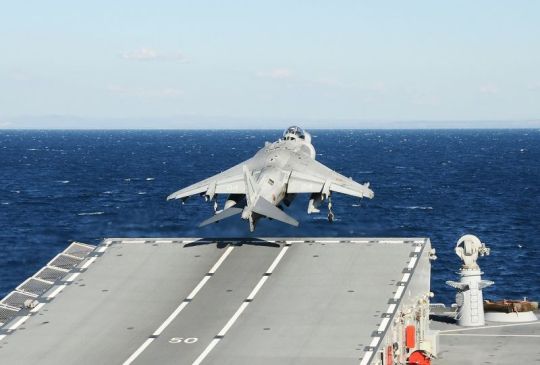
-An Italian AV-8B+ launching from the carrier Cavour’s ski jump. | Photo: Aldo Bidini
Already an operator of AV-8A Matadors, the Spanish Navy was the first international operator of the AV-8B Harrier II, ordering 12 of its own variants, known as the VA-2 Matador II. The Matadors operated from Príncipe de Asturias beginning in 1989. In 1993, an additional eight VA-2+ (the equivalent of the AV-8B+) were ordered, along with a TAV-8B trainer. In 2000, Boeing (which had absorbed McDonnell Douglas) signed a contract to upgrade a number of early model VA-2s (the number varies from 2-11) to Harrier Plus standards, allowing them to carry AIM-120 missiles. Due to budget constraints, only five of the original Matador IIs were upgraded. The Matadors were part of Spain’s commitment to Operation DENY FLIGHT, enforcing the UN’s no-fly zone over Bosnia and Herzegovina. After the Asturias was decommissioned in 2013, the Matador IIs operate from the amphibious assault ship Juan Carlos I. Spain was interested in replacing the VA-2s with F-35Bs, but has instead settled on extending the Matador’s service life, citing the cost of replacements.

-A Matador II+ over RIAT in 2019. | Photo: Airwolfhound
The first RAF Harrier II, known as the GR.5, entered service in 1987, replacing earlier GR.1 and GR.3 variants. The GR.5 differed from the AV-8B in that it had stainless steel leading edges to meet RAF bird-strike requirements, as well as in avionics and weapons. The RAF’s GR.5s were considered too immature a system to be deployed for the 1991 Gulf War, though several were dispatched to patrol the no-fly zones in 1993. Beginning in 1990 BAe began testing an upgraded Harrier II GR.7, which was broadly similar to the Night Attack AV-8B. After a successful test program 34 GR.7 were delivered through 1991, with the existing GR.5s upgraded beginning the same year. The GR.7s, hastily modified with GPS navigation, were deployed with NATO forced to the former Yugoslavia, and carried out recon and strike missions, often dropping LGBs on targets designated by SEPECAT Jaguars. Later, GR.7s were part of the UK’s commitment to the wars in Afghanistan and Iraq. Beginning in the middle 2000s, BAe began development of the GR.9 upgrade, which would improve communications, ground proximity warning and navigation systems, followed by the integration of the AGM-65 Maverick air-to-ground missile. The GR.9 upgrade also included replacement of fatigued airframe components. GR.9s were deployed to Afghanistan in 2007, allowing aged GR.7s to be withdrawn. The stresses of war and advancing age of the fleet caused the wholesale retirement of the RAF’s Harrier IIs in 2011, with their tasks being assigned to Tornado GR.4s until delivery of the F-35B Lightning.

-A Royal Air Force Harrier GR.9 conducts a combat patrol over Afghanistan, equipped with a laser-designator pod and armed with Paveway guided bombs. | Photo: USAF
#aircraft#aviation#avgeek#cold war#airplanes#airplane#cold war history#coldwar#aviation history#mcdonnell douglas#bae#british aerospace#AV-8B#av 8b#av8b#gr7#gr9#harrier gr7#harrier gr9#usmc#raf#rn#royal air force#royal navy
23 notes
·
View notes
Text
Artificial Intelligence: A Brief History
Ancient Greek mythology included intelligent robots and artificial entities for the first time. The creation of syllogism and its application of deductive reasoning by Aristotle was a watershed point in humanity's search to comprehend its own intelligence. Despite its long and deep roots, artificial intelligence as we know it today has only been around for a century. The following is a quick rundown of some of the most significant AI events.
1940s * "A Logical Calculus of Ideas Immanent in Nervous Activity," by Warren McCullough and Walter Pitts, is published in 1943. The first mathematical model for developing a neural network was proposed in this publication. (1949) Donald Hebb offers the hypothesis that brain pathways are formed by experiences and that connections between neurons become stronger the more they are used in his book The Organization of Behavior: A Neuropsychological Theory. In AI, Hebbian learning remains an essential model.
1950s Alan Turing publishes "Computing Machinery and Intelligence" in 1950, suggesting the Turing Test, a method for detecting whether or not a machine is intelligent. Marvin Minsky and Dean Edmonds, Harvard undergraduates, create SNARC, the first neural network computer, in 1950. Claude Shannon publishes "Programming a Computer for Playing Chess" in 1950.
*
The "Three Laws of Robotics" are published by Isaac Asimov in 1950.
*
Arthur Samuel creates a checkers self-learning software in 1952.
(1954) In the Georgetown-IBM machine translation experiment, 60 carefully selected Russian sentences are mechanically translated into English.
At the "Dartmouth Summer Research Project on Artificial Intelligence" in 1956, the term "artificial intelligence" is developed. The conference, which established the scope and goals of AI and was led by John McCarthy, is largely regarded as the genesis of artificial intelligence as we know it today.
*
Allen Newell and Herbert Simon exhibit the first reasoning program, Logic Theorist (LT), in 1956.
John McCarthy creates Lisp, an AI programming language, and publishes his article "Programs with Common Sense" in 1958. The paper proposed the Advice Taker, a complete AI system capable of learning from experience in the same way as humans do.
* In 1959, Allen Newell, Herbert Simon, and J.C. Shaw created the General Problem Solver (GPS), a computer program that mimics human problem-solving.
*
Herbert Gelernter created the Geometry Theorem Prover program in 1959.
*
While working at IBM in 1959, Arthur Samuel coined the phrase "machine learning."
The MIT Artificial Intelligence Project was started by John McCarthy and Marvin Minsky in 1959.
1960s
*
John McCarthy establishes the Stanford AI Lab in 1963.
* 1966) The Automatic Language Processing Advisory Committee (ALPAC) report by the U.S. government details the lack of progress in machine translations research, a major Cold War initiative with the promise of automatic and instantaneous translation of Russian. The ALPAC report leads to the cancellation of all government-funded MT projects.
* (1969) The first successful expert systems are developed in DENDRAL, a XX program, and MYCIN, designed to diagnose blood infections, are created at Stanford.
1970s
* (1972) The logic programming language PROLOG is created.
* 1973) The British government releases the "Lighthill Report," which details AI research failures and results in significant funding cuts for AI initiatives. (1974-1980) Dissatisfaction with AI progress leads to significant DARPA reductions in research grants. Artificial intelligence funding is drying up, and research is stagnating, according to the ALPAC study and the previous year's "Lighthill Report." The "First AI Winter" occurs during this time.
1980s
R1 (also known as XCON), the first successful commercial expert system, is developed by Digital Equipment Corporations in 1980. R1, which is designed to configure orders for new computer systems, kicks off a decade-long investment boom in expert systems, essentially ending the first "AI Winter."
*
The ambitious Fifth Generation Computer Systems project is launched by Japan's Ministry of International Trade and Industry in 1982. The purpose of FGCS is to create a platform for AI development and supercomputer-like performance.
1983) In response to Japan's FGCS, the US government develops the Strategic Computing Initiative, which will fund advanced computing and artificial intelligence research through DARPA. (1985) Companies invest over a billion dollars a year on expert systems, and an entire sector called the Lisp machine market emerges to support them. Symbolics and Lisp Machines Inc. are two companies that make customized computers that run on the AI programming language Lisp.
1987-1993) As computing technology advanced, cheaper alternatives arose, and the Lisp machine market crashed in 1987, kicking off the "Second AI Winter." Expert systems became too expensive to operate and update during this time, and they finally fell out of favor.
1990s
During the Gulf War in 1991, US forces used DART, an automated logistical planning and scheduling program.
(1992) Japan cancels the FGCS project in 1992, alleging failing to reach the grandiose targets set a decade before.
DARPA terminated the Strategic Computing Initiative in 1993, after spending over $1 billion and falling short of expectations. (1997) World chess champion Gary Kasparov is defeated by IBM's Deep Blue in the 2000s
*
(2005) The DARPA Grand Challenge is won by STANLEY, a self-driving automobile.
2005: The United States military began to invest in self-driving robots such as Boston Dynamics' "Big Dog" and iRobot's "PackBot."
*
(2008) Google develops advancements in speech recognition and makes the feature available via its iPhone app.
2010-2014
*
On Jeopardy!, IBM's Watson beats out the competition.
(2011) Apple's iOS operating system introduces Siri, an AI-powered virtual assistant.
* In 2012, Andrew Ng, the inventor of the Google Brain Deep Learning project, fed 10 million YouTube videos as a training set to a neural network using deep learning methods. The neural network learns to recognize a cat without being informed what a cat is, ushering in a new era of deep learning funding and neural networks. (2014) Google's self-driving car passes a state driving test for the first time. From 2015 through 2021, Amazon's Alexa, a virtual home, will be available.
*
(2016) World champion Go player Lee Sedol is defeated by Google DeepMind's AlphaGo. The ancient Chinese game's complexity was seen as a significant barrier to overcome in AI.
* (2016) Hanson Robotics develops Sophia, a humanoid robot capable of facial recognition, verbal conversation, and facial expression, as the world's first "robot citizen."
*
(2018) Google releases BERT, a natural language processing engine that lowers hurdles to machine learning applications' translation and interpretation.
*
(2018) Waymo announces the Waymo One service, which allows consumers in the Phoenix metro region to order a pick-up from one of the company's self-driving cars.
* (2020) Baidu makes its LinearFold AI algorithm available to scientific and medical teams working on a vaccine during the SARS-CoV-2 pandemic's early phases. The system can anticipate the virus's RNA sequence in just 27 seconds, which is 120 times faster than prior methods.
2 notes
·
View notes
Text


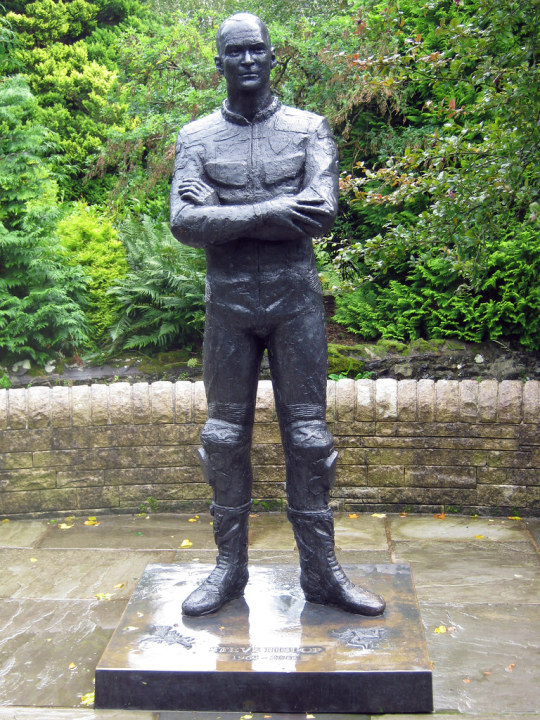

Steve Hislop the Scottish motorcycle racer was born on 11th January 1962.
Hizzy, as he was affectionately known once said “If I’d never thrown my leg over a bike, I’d never have lived.”
Robert Steven Hislop grew up in the village of Chesters, near Hawick in the borders. His father started the interest of both he and his brother Garry in motorcycle racing. This was short lived at the time as he lost his father and a few years later his brother was killed at Silloth circuit. He ended up with a serious alcohol problem which led into depression.
Hizzy thankfully recovered and began his Isle of Man road racing career in 1983 by finishing second in the newcomers’ race at the Manx Grand Prix.
On short circuits, his first championship success came when he won the 250cc British Championship in 1990. Superbike victory followed with the British Superbike Championship in 1995. Some attributed his success to James Whitham leaving the series mid-season to deal with cancer.
Although he did not take a BSB victory in 1996 or 1997, Hislop was hired by Rob McElnea’s dominant Cadbury’s Boost Yamaha team for 1998. The nature of the fight for the championship between Hislop & team mate, fellow Scot. Niall Mackenzie, was illustrated by a near-collision on the last lap at Snetterton which cost the team a 1-2 finish. Hislop generally matched his countryman before a serious crash took him out of title contention.
His last championship success came in 2002 when he won the British Superbike Championship riding a Ducati. A notable feature of his season resulted from Hislop lapping Donington Park circuit more quickly on a superbike than the fastest Moto GP machine: Hislop’s modified production Ducati was heavier and less powerful than the bespoke Grand Prix bikes.
The 1992 Senior TT was described as an absolute classic. It is often described as one of the best races in TT history.
After their successful 1991 TT on all conquering Honda RVF machines, Hislop and Carl Fogarty had not planned to return in 1992. However, they both lined up on the Glencrutchery Road that year on unfancied machinery: Hislop was ona Norton with Fogarty on a Yamaha. The Norton Hizzy rode had been developed on a shoe string budget when compared with the Japanese competition. John Player had no intention of backing Steve’s TT campaign but after scratching around for some support and with minimal testing time, the team headed for the Isle of Man.
Hislop’s Norton took to the circuit in the unconventional white livery of Steve’s long term sponsor Abus. Hislop and the team defied the bike’s detractors by taking a fine 2nd place in the opening TT F1 race. The bike proved it could complete 6 laps of the gruelling Snaefell Mountain Course in hot weather so the team looked forward to Friday’s Senior TT.
Hislop’s main rival was Foggarty, who started at number 4. Steve started at 19. Not only did this give Hizzy more traffic to contend with but it also gave the crowd an anxious wait as the officials calculated the time difference between them. As the race progressed, the two riders smashed records they set the previous year with Hislop taking a narrow advantage into the final lap. In a last-ditch attempt to catch Hislop, Fogarty recorded a record lap time of more than 123 mph on his Yamaha. It was all in vain however as Hislop guided the fly splattered Norton home to an historic win. This was one of Hislop’s greatest achievements and one of the most popular TT wins. Carl Fogarty’s lap record stood for 7 years.
Hislop and Fogarty went on to become two of Britain’s most successful motorcycle racers, winning many races and championships. It was the 1992 Senior TT that saw them battle together for the last time.
Described by some as a flawed sporting genius, success in the world championships never materialised for Hislop. This was possibly because of a self-destructive aspect to his character. The flaw may have led to a number of well-publicised clashes with other riders and teams in the British championships which hindered progress into international series.
Having lost his brother and many friends in motorcycle accidents, he made a point of never going to the funerals of fellow racers, saying:
“Some people might find that a bit callous. I only ever attend family ones and people find it a bit strange that I won’t go to a friend’s funeral, but it’s just my little way of shutting off.”
Steve Hislop died in a helicopter accident in July 2003, near Teviothead, Roxburghshire and was interred in the village of Chesters near his birthplace of Hawick, Scotland. He had two children.
There is a bronze statue in memory of Hizzy in the grounds of Hawick Museum. at Wilton park and another at Onchan Head, Isle of Man, zas seen in order in the pics. The last pic is a cairn near Teviothead, the scene of the helicopter crash, it reads……
‘Hizzy’
This cairn was built by a
few friends of Steve Hislop,
British Superbike Champion,
who was tragically killed in a
helicopter accident near this site,
on July 30th 2003.
Kind permission was granted
by His Grace
The Duke of Buccleuch.
#scotland#scottish#scottish borders#motorcycle racer#motorsport#isle of man tt#champion#sporting history
9 notes
·
View notes
Text
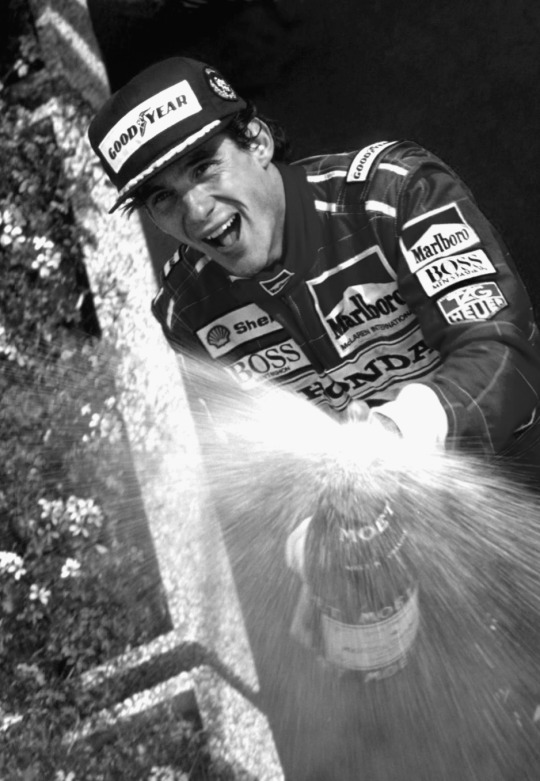
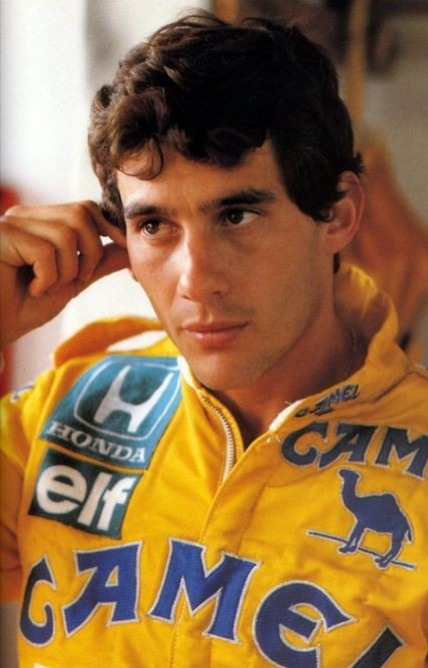
Happy birthday AYRTON SENNA!!!!!!!!!!!!!! (21/03/1960 - ∞) 🧡⚡
Racing, competing, it's in my blood. It's part of me, it's part of my life; I have been doing it all my life and it stands out above everything else.
Ayrton Senna da Silva was born in São Paulo in a wealthy Brazilian family, he had an older sister, Viviane, and a younger brother, Leonardo. As a small boy he had poor motor coordination and by the age of three he had trouble climbing stairways (that's why his parents nicknamed him "Beco"), after a few medical examinations the doctors established that he wasn't suffering from any problems. Despite that he was highly athletic, excelling in gymnastics and many other sports, at four years old he developed an interest in cars and motoracing which led him to learn to drive a Jeep around his family farm at the age of seven.
His motoracing career officially started when he was thirteen, he begun participating in karting competitions; in 1977 he went on to win the South American Kart Championship, he then continued to racing karts until 1982, finishing as a runner up for the championship in 1979 and 1980. But in 1981 Ayrton took a big step: he moved to Eaton in England to be able to begin single-seater racing and that very same year he went on winning the RAC and the Townsend Thoresen Formula Ford 1600 championships. Even though his family wanted him to take a role in the family business, he preferred to continue his racing career since he was offered a drive with a Formula Ford 2000 team with which he won the 1982 British and European Formula Ford 2000 Championships. The next year he moved to race in the British Formula Three Championship which he he won after a closely fought battle with Martin Brundle.
After a series of tests with various F1 teams (including McLaren, Williams and Brabham) in 1984 Ayrton made his F1 debut at the Brazilian GP with Toleman, that at the time was a relatively new team; through out the season he consistently outperformed his car, like it happened at the Monaco GP where, despite the awful conditions, he finished the race in second place. The next season he signed up with Lotus and stayed with the team from 1985 to 1987 until he moved to McLaren in 1988, joining Alain Prost in the team with whom he started one of the most iconic, and controversial, rivalries. The rivalry between the two drivers intensified so much that it forced Alain to leave the team to join Ferrari in 1990, while Ayrton stayed with McLaren until 1993, then he signed with the Williams team for the 1994 season, which will be his last one due to his fatal accident at the San Marino GP.
Still to this day Ayrton is considered by many to be one of the greatest driver ever to grace the sport. In total he won three World Championships in 1988,1989 and 1991 with the McLaren team and had 41 race wins through out his career. He still holds the record for most wins at the Monaco GP (6),which five of them were consecutive.
171 notes
·
View notes
Text
Events 1.17
38 BC – Octavian divorces his wife Scribonia and marries Livia Drusilla, ending the fragile peace between the Second Triumvirate and Sextus Pompey.
1362 – Saint Marcellus' flood kills at least 25,000 people on the shores of the North Sea.
1377 – Pope Gregory XI reaches Rome, after deciding to move the Papacy back to Rome from Avignon.
1524 – Giovanni da Verrazzano sets sail westward from Madeira to find a sea route to the Pacific Ocean.
1562 – France grants religious toleration to the Huguenots in the Edict of Saint-Germain.
1595 – During the French Wars of Religion, Henry IV of France declares war on Spain.
1608 – Emperor Susenyos I of Ethiopia surprises an Oromo army at Ebenat; his army reportedly kills 12,000 Oromo at the cost of 400 of his men.
1648 – England's Long Parliament passes the "Vote of No Addresses", breaking off negotiations with King Charles I and thereby setting the scene for the second phase of the English Civil War.
1773 – Captain James Cook leads the first expedition to sail south of the Antarctic Circle.
1781 – American Revolutionary War: Battle of Cowpens: Continental troops under Brigadier General Daniel Morgan defeat British forces under Lieutenant Colonel Banastre Tarleton at the battle in South Carolina.
1799 – Maltese patriot Dun Mikiel Xerri, along with a number of other patriots, is executed.
1811 – Mexican War of Independence: In the Battle of Calderón Bridge, a heavily outnumbered Spanish force of 6,000 troops defeats nearly 100,000 Mexican revolutionaries.
1852 – The United Kingdom signs the Sand River Convention with the South African Republic.
1873 – A group of Modoc warriors defeats the United States Army in the First Battle of the Stronghold, part of the Modoc War.
1885 – A British force defeats a large Dervish army at the Battle of Abu Klea in the Sudan.
1893 – Lorrin A. Thurston, along with the Citizens' Committee of Public Safety, led the Overthrow of the Kingdom of Hawaii and the government of Queen Liliʻuokalani.
1899 – The United States takes possession of Wake Island in the Pacific Ocean.
1903 – El Yunque National Forest in Puerto Rico becomes part of the United States National Forest System as the Luquillo Forest Reserve.
1904 – Anton Chekhov's The Cherry Orchard receives its premiere performance at the Moscow Art Theatre.
1912 – British polar explorer Captain Robert Falcon Scott reaches the South Pole, one month after Roald Amundsen.
1915 – Russia defeats Ottoman Turkey in the Battle of Sarikamish during the Caucasus Campaign of World War I.
1917 – The United States pays Denmark $25 million for the Virgin Islands.
1918 – Finnish Civil War: The first serious battles take place between the Red Guards and the White Guard.
1920 – Alcohol Prohibition begins in the United States as the Volstead Act goes into effect.
1941 – Franco-Thai War: Vichy French forces inflict a decisive defeat over the Royal Thai Navy.
1943 – World War II: Greek submarine Papanikolis captures the 200-ton sailing vessel Agios Stefanos and mans her with part of her crew.
1944 – World War II: Allied forces launch the first of four assaults on Monte Cassino with the intention of breaking through the Winter Line and seizing Rome, an effort that would ultimately take four months and cost 105,000 Allied casualties.
1945 – World War II: The Vistula–Oder Offensive forces German troops out of Warsaw.
1945 – The SS-Totenkopfverbände begin the evacuation of the Auschwitz concentration camp as Soviet forces close in.
1945 – Swedish diplomat Raoul Wallenberg is taken into Soviet custody while in Hungary; he is never publicly seen again.
1946 – The UN Security Council holds its first session.
1948 – The Renville Agreement between the Netherlands and Indonesia is ratified.
1950 – The Great Brink's Robbery: Eleven thieves steal more than $2 million from an armored car company's offices in Boston.
1950 – United Nations Security Council Resolution 79 relating to arms control is adopted.
1961 – U.S. President Dwight D. Eisenhower delivers a televised farewell address to the nation three days before leaving office, in which he warns against the accumulation of power by the "military–industrial complex" as well as the dangers of massive spending, especially deficit spending.
1961 – Former Congolese Prime Minister Patrice Lumumba is murdered in circumstances suggesting the support and complicity of the governments of Belgium and the United States.
1966 – Palomares incident: A B-52 bomber collides with a KC-135 Stratotanker over Spain, killing seven airmen, and dropping three 70-kiloton nuclear bombs near the town of Palomares and another one into the sea.
1969 – Black Panther Party members Bunchy Carter and John Huggins are killed during a meeting in Campbell Hall on the campus of UCLA.
1977 – Capital punishment in the United States resumes after a ten-year hiatus, as convicted murderer Gary Gilmore is executed by firing squad in Utah.
1981 – President of the Philippines Ferdinand Marcos lifts martial law eight years and five months after declaring it.
1991 – Gulf War: Operation Desert Storm begins early in the morning as aircraft strike positions across Iraq, it is also the first major combat sortie for the F-117. LCDR Scott Speicher's F/A-18C Hornet from VFA-81 is shot down by a Mig-25 and is the first American casualty of the War. Iraq fires eight Scud missiles into Israel in an unsuccessful bid to provoke Israeli retaliation.
1991 – Crown prince Harald V of Norway becomes King Harald V, following the death of his father, King Olav V.
1992 – During a visit to South Korea, Japanese Prime Minister Kiichi Miyazawa apologizes for forcing Korean women into sexual slavery during World War II.
1994 – The 6.7 Mw Northridge earthquake shakes the Greater Los Angeles Area with a maximum Mercalli intensity of IX (Violent), leaving 57 people dead and more than 8,700 injured.
1995 – The 6.9 Mw Great Hanshin earthquake shakes the southern Hyōgo Prefecture with a maximum Shindo of VII, leaving 5,502–6,434 people dead, and 251,301–310,000 displaced.
1996 – The Czech Republic applies for membership of the European Union.
1997 – Cape Canaveral Air Force Station: A Delta II carrying the GPS IIR-1 satellite explodes 13 seconds after launch, dropping 250 tons of burning rocket remains around the launch pad.
1998 – Lewinsky scandal: Matt Drudge breaks the story of the Bill Clinton–Monica Lewinsky affair on his Drudge Report website.
2002 – Mount Nyiragongo erupts in the Democratic Republic of the Congo, displacing an estimated 400,000 people.
2007 – The Doomsday Clock is set to five minutes to midnight in response to North Korea's nuclear testing.
2010 – Rioting begins between Muslim and Christian groups in Jos, Nigeria, results in at least 200 deaths.
1 note
·
View note
Text
Movies, Smells & CRISPR
Movies coming in May - https://comicbook.com/movies/2019/04/30/movies-arriving-may-2019/#6
Bad sense of smell predicts early death - https://www.newscientist.com/article/2201021-a-bad-sense-of-smell-predicts-early-death-but-we-dont-know-why/
CRISPR storing GIFS - https://www.alphr.com/bioscience/1006302/scientists-have-used-crispr-to-store-a-gif-inside-the-dna-of-a-living-cell
Games currently playing
Buck
– Assassin’s Creed Unity - https://store.steampowered.com/app/289650/Assassins_Creed_Unity/
Professor
– Minecraft - https://www.minecraft.net/en-us/
DJ
– Mortal Kombat 11 - https://store.steampowered.com/app/976310/Mortal_Kombat11/
Other topics discussed
A Dog’s Journey (film)
- https://en.wikipedia.org/wiki/A_Dog%27s_Journey_(film)
Isle of Dogs (film)
- https://en.wikipedia.org/wiki/Isle_of_Dogs_(film)
The Professor (film)
- https://en.wikipedia.org/wiki/The_Professor_(2018_film)
John Wick: Chapter 3 – Parabellum (film)
- https://en.wikipedia.org/wiki/John_Wick:_Chapter_3_%E2%80%93_Parabellum
Clara (film)
- https://en.wikipedia.org/wiki/Clara_(film)
The Professor & the Madman (film)
- https://en.wikipedia.org/wiki/The_Professor_and_the_Madman_(film)
Aladdin (2019 disney film)
- https://en.wikipedia.org/wiki/Aladdin_(2019_film)
Sonic the Hedgehog (2019 film)
- https://en.wikipedia.org/wiki/Sonic_the_Hedgehog_(film)
Tolkien (film)
- https://en.wikipedia.org/wiki/Tolkien_(film)
Rock of Ages (film)
- https://en.wikipedia.org/wiki/Rock_of_Ages_(2012_film)
Bohemian Rhapsody (film)
- https://en.wikipedia.org/wiki/Bohemian_Rhapsody_(film)
Godzilla: King of the Monsters (2019 film)
- https://en.wikipedia.org/wiki/Godzilla:_King_of_the_Monsters_(2019_film)
Plucking nose hairs is not a good idea
- https://www.businessinsider.com.au/why-you-shouldnt-pluck-your-nose-hairs-2016-7?r=US&IR=T
How to pronounce GIF
- https://bits.blogs.nytimes.com/2013/05/23/battle-over-gif-pronunciation-erupts/
Ways to add CRISPR into the body
- https://www.technologyreview.com/s/608898/five-ways-to-get-crispr-into-the-body/
A New World Order podcast
- https://thatsnotcanon.com/anewworldorder
Big Fat Liar (film)
- https://en.wikipedia.org/wiki/Big_Fat_Liar
Y2K of GPS
- https://www.abc.net.au/news/science/2019-04-05/gps-rollover-global-positioning-system-receivers-satellites/10966218
Gal Gadot’s stunt double in Wonder Woman movie
- http://www.espn.com/espnw/culture/article/19510724/stunt-double-caitlin-dechelle-wonder-woman-real-life-superpowers
Maxwell Klinger (M*A*S*H character)
- https://mash.fandom.com/wiki/Maxwell_Q._Klinger
Shoutouts
27 Apr 1922 – Record breaking Sheila Scott was born, she later in life went on to become an accomplished female pilot. In 1966, Sheila made her first around-the-world flight, covering about 31,000 miles in 189 flying hours. It was the first such solo flight by a British subject, the longest-distance solo flight, and only the third around-the-world flight by a woman. Then records began to tumble: between London and Cape Town in 1967; across the North Atlantic the same year; across the South Atlantic in 1969; from equator to equator over the North Pole in 1971, becoming the first woman to pilot a flight circling the world by way of the North Pole in a light aircraft. After her record polar flight, she made a third around-the-world flight, earning her 100th world-class record, including a new time from Darwin, Australia, to London of three and a half days, beating the previous record by one and a half days. In 1967, she set 23 world records in just one year. - https://www.onthisday.com/articles/record-breaking-sheila-the-high-flying-aviator
29 Apr 2019 - Dragon Ball Creator Akira Toriyama has been nominated in the "Voters Choice" category for the Eisner Hall of Fame awards - https://comicbook.com/anime/2019/04/29/dragon-ball-akira-toriyama-eisner-award-nomination-2019/
30 Apr 1888 – 1888 Moradabad hailstorm: hail stones allegedly as big as oranges kill 246 people and some 1600 sheep and cattle in Moradabad, Uttar Pradesh - https://en.wikipedia.org/wiki/1888_Moradabad_hailstorm
30 Apr 1989 - World Wide Web (WWW) is first launched in the public domain by CERN scientist Sir Tim Berners-Lee - https://www.onthisday.com/people/tim-berners-lee
Remembrances
29 Apr 2019 – John Singleton, American film director, screenwriter, and producer. He was best known for directing Boyz n the Hood (1991), for which he was nominated for the Academy Award for Best Director, becoming, at age 24, the first African American and youngest person to have ever been nominated for that award. Singleton was a native of South Los Angeles, and many of his films, such as Poetic Justice (1993), Higher Learning (1995), and Baby Boy (2001), had themes which resonated with the contemporary urban population. He also directed the drama Rosewood (1997) and the action films Shaft (2000), 2 Fast 2 Furious (2003), and Four Brothers (2005). He co-created the television crime drama Snowfall. He died of a stroke at 51 in Los Angeles, California - https://en.wikipedia.org/wiki/John_Singleton
29 Apr 2019 – Les Murray, Australian poet, anthologist and critic. His career spanned over 40 years and he published nearly 30 volumes of poetry as well as two verse novels and collections of his prose writings. His poetry won many awards and he is regarded as "the leading Australian poet of his generation". He was rated by the National Trust of Australia as one of the 100 Australian Living Treasures. He died at 80 in Taree, New South Wales. - https://en.wikipedia.org/wiki/Les_Murray_(poet)
30 Apr 1792 - John Montagu, 4th Earl of Sandwich, a British statesman who succeeded his grandfather Edward Montagu, 3rd Earl of Sandwich as the Earl of Sandwich in 1729, at the age of ten. During his life, he held various military and political offices, including Postmaster General, First Lord of the Admiralty, and Secretary of State for the Northern Department. He is also known for the claim that he was the eponymous inventor of the sandwich. He died at 73 in Chiswick,England - https://en.wikipedia.org/wiki/John_Montagu,_4th_Earl_of_Sandwich
30 Apr 1974 - Agnes Moorehead, American actress whose 41-year career included work in radio, stage, film, and television. She is best known for her role as Endora on the television series Bewitched, but she also has notable roles in films, including Citizen Kane, The Magnificent Ambersons, Dark Passage, All That Heaven Allows, Show Boat, and Hush...Hush, Sweet Charlotte. Moorehead rarely played lead roles, but her skill at character development and range earned her one Primetime Emmy Award and two Golden Globe Awards in addition to nominations for four Academy Awards and six Emmy Awards. She was the first woman to host the Oscars ceremony. Her transition to television won acclaim for drama and comedy. She could play many different types, but often portrayed haughty, arrogant characters. She died of uterine cancer at 73 in Rochester, Minnesota - https://en.wikipedia.org/wiki/Agnes_Moorehead
Famous Birthdays
30 Apr 1921 - Roger L. Easton, American scientist/physicist who was the principal inventor and designer of the Global Positioning System (GPS), along with Ivan A. Getting and Bradford Parkinson. He was born in Craftsbury, Vermont - https://en.wikipedia.org/wiki/Roger_L._Easton
30 Apr 1985 – Gal Gadot, Israeli actress and model. At age 18, she was crowned Miss Israel 2004. She then served two years in the Israel Defense Forces as a combat instructor, and began studying law and international relations at IDC Herzliya college while building up her modeling and acting careers. Gadot's first international film role came as Gisele Yashar in Fast & Furious (2009), a role she reprised in subsequent installments of the film franchise. She went on to earn worldwide fame for portraying Wonder Woman in the DC Extended Universe, beginning with Batman v Superman: Dawn of Justice (2016), followed by the solo film Wonder Woman and the ensemble Justice League (both 2017). In 2018, Gadot was included on Time's annual list of the 100 most influential people in the world, and was listed among the highest-paid actresses in the world. She was born in Petah Tikva, Israel - https://en.wikipedia.org/wiki/Gal_Gadot
1 May 1738 - Kamehameha 1, Hawaiian conqueror who united the Hawaiian Islands and formally established the Kingdom of Hawaiʻi in 1810. He was born in Kohala, Hawaii
- https://www.onthisday.com/people/kamehameha-i
- https://en.wikipedia.org/wiki/Kamehameha_I
1 May 1923 - Joseph Heller, American author of novels, short stories, plays and screenplays. His best-known work is the novel Catch-22, a satire on war and bureaucracy, whose title has become a synonym for an absurd or contradictory choice. He was born in Brooklyn, New York - https://en.wikipedia.org/wiki/Joseph_Heller
Events of Interest
1 May 1786 - Wolfgang Amadeus Mozart's opera "Marriage of Figaro" premieres in Vienna with Mozart himself directing - https://www.history.com/this-day-in-history/mozarts-le-nozze-di-figaro-premieres-in-vienna
1 May 1840 - The Penny Black was the world's first adhesive postage stamp used in a public postal system was first issued. It was not valid for use until 6 May. The Penny Black features a profile of Queen Victoria. - https://en.wikipedia.org/wiki/Penny_Black
1 May 1994 – Three-time Formula One world champion Ayrton Senna is killed in an accident whilst leading the San Marino Grand Prix at Imola. - https://en.wikipedia.org/wiki/Death_of_Ayrton_Senna
1 May 1999 - SpongeBob SquarePants premiere on Nickelodeon after the 1999 Kids' Choice Awards. It has received worldwide critical acclaim since its premiere and gained enormous popularity by its second season. - https://en.wikipedia.org/wiki/Spongebob_squarepants
Intro
Artist – Goblins from Mars
Song Title – Super Mario - Overworld Theme (GFM Trap Remix)
Song Link - https://www.youtube.com/watch?v=-GNMe6kF0j0&index=4&list=PLHmTsVREU3Ar1AJWkimkl6Pux3R5PB-QJ
Follow us on Facebook - https://www.facebook.com/NerdsAmalgamated/
Email - [email protected]
Twitter - https://twitter.com/NAmalgamated
Spotify - https://open.spotify.com/show/6Nux69rftdBeeEXwD8GXrS
iTunes - https://itunes.apple.com/au/podcast/top-shelf-nerds/id1347661094
RSS - http://www.thatsnotcanonproductions.com/topshelfnerdspodcast?format=rss
#movies#nerd#pop culture#aladdin#minecraft#movie news#events of interest#biology#internet#science and tech#human biology
1 note
·
View note
Text
Reference List:
References:
Barwood, M. J., Weston, N. J. V., Thelwell, R., & Page, J. (2009). A motivational music and video intervention improves high-intensity exercise performance. Journal of Sports Science and Medicine, 8(3), 435–442.
Barron, D., Ball, G., Robins, M., & Sunderland, C. (2018). Artificial neural networks and player recruitment in professional soccer. PLoS ONE, 13(10), 1–11. https://doi.org/10.1371/journal.pone.0205818
Hughes, M., & Franks, I. M. (Eds.). (2004). Notational analysis of sport: Systems for better coaching and performance in sport. Psychology Press.
Bourdon, P. C., Cardinale, M., Murray, A., Gastin, P., Kellmann, M., Varley, M. C. Cable, N. T. (2017). Monitoring athlete training loads: Consensus statement. International Journal of Sports Physiology and Performance, 12, 161–170. https://doi.org/10.1123/IJSPP.2017-0208
Butler, R. J., & Hardy, L. (2016). The Performance Profile: Theory and Application. The Sport Psychologist, 6(3), 253–264. https://doi.org/10.1123/tsp.6.3.253
Butterworth, A., O’Donoghue, P., & Cropley, B. (2013). Performance profiling in sports coaching: A review. International Journal of Performance Analysis in Sport, 13(3), 572–593. https://doi.org/10.1080/24748668.2013.11868672
Carling, C., Reilly, T. and Williams, A.M. (2009). Performance Assessment for Field Sports, London: Routledge.
Dowrick, P.W. (1991). Practical guide to using video in behavioural sciences. In T. Reilly, J. Hughes and M. Hughes (Eds.), Science and Football III (pp. 267-278). London, UK: E & FN Spon.
Franks, I.M. and Miller, G. (1991). ‘Training coaches to observe and remember’, Journal of Sports Sciences, 9: 285–97.
Gabbett, T. J., Nassis, G. P., Oetter, E., Pretorius, J., Johnston, N., Medina, D., … Ryan, A. (2017). The athlete monitoring cycle: A practical guide to interpreting and applying training monitoring data. British Journal of Sports Medicine, 51(20), 1451–1452. https://doi.org/10.1136/bjsports-2016-097298
Groom, R., & Cushion, C. (2005). Using of Video Based Coaching With Players: A Case Study. International Journal of Performance Analysis in Sport, 5(3), 40–46. https://doi.org/10.1080/24748668.2005.11868336
Groom, R., Cushion, C., & Nelson, L. (2011). The delivery of video-based performance analysis by england youth soccer coaches: Towards a grounded theory. Journal of Applied Sport Psychology, 23(1), 16–32. https://doi.org/10.1080/10413200.2010.511422
Høigaard, R., Säfvenbom, R., & Tønnessen, F. E. (2006). The relationship between group cohesion, group norms, and perceived social loafing in soccer teams. Small group research, 37(3), 217-232.
Hughes, M. D., & Bartlett, R. M. (2002). The use of performance indicators in performance analysis. / Utilisation des indicateurs de performance pour l ’ analyse de cette performance. Journal of Sports Sciences, 20(10), 739–754. Retrieved from http://articles.sirc.ca/search.cfm?id=S-847006%5Cnhttp://www.tandf.co.uk/journals%5Cnhttp://search.ebscohost.com/login.aspx?direct=true&db=s3h&AN=SPHS-847006&site=ehost-live
Hughes, M., Caudrelier, T., James, N., Redwood-Brown, A., Donnelly, I., Kirkbride, A., & Duschesne, C. (2012). Moneyball and soccer - An analysis of the key performance indicators of elite male soccer players by position. Journal of Human Sport and Exercise, 7(SPECIALISSUE.2), 402–412. https://doi.org/10.4100/jhse.2012.72.06
Hughes, M & I, Franks. (2018). Analysis of Notation Data. Essentials of Performance Analysis in Sport, 169–179. https://doi.org/10.4324/9781315776743-11
Jenkins, E. R., Morgan, L., & O’Donoghue, P. (2007). A case study into the effectiveness of computerised match analysis and motivational videos within the coaching of a league netball team. International Journal of Performance Analysis in Sport, 7(2), 59–80. https://doi.org/10.1080/24748668.2007.11868397
Kolb, D. A. (1984). Experiential Learning: Experience as The Source of Learning and Development. Prentice Hall, Inc., (1984), 20–38. https://doi.org/10.1016/B978-0-7506-7223-8.50017-4
Krenn, B., Würth, S., & Hergovich, A. (2013). The impact of feedback on goal setting and task performance: Testing the feedback intervention theory. Swiss Journal of Psychology, 72(2), 79–89. https://doi.org/10.1024/1421-0185/a000101
Lyons, K. (1988). Using video in sport, Huddersfield: Springfield Books.
Mackenzie, R., & Cushion, C. (2013). Performance analysis in football: A critical review and implications for future research. Journal of Sports Sciences, 31(6), 639–676. https://doi.org/10.1080/02640414.2012.746720
Mellalieu, S. D., Hanton, S., & Thomas, O. (2009). The effects of a motivational general-arousal imagery intervention upon preperformance symptoms in male rugby union players. Psychology of Sport and Exercise, 10(1), 175–185. https://doi.org/10.1016/j.psychsport.2008.07.003
O’Donoghue, P. (2006). The use of feedback videos in sport. International Journal of Performance Analysis in Sport, 6(2), 1–14. https://doi.org/10.1080/24748668.2006.11868368
O’Donoghue, P. (2009). Research methods for sports performance analysis. In Research Methods for Sports Performance Analysis. https://doi.org/10.4324/9780203878309
Rossi, A., Perri, E., Trecroci, A., Savino, M., Alberti, G., & Iaia, F. M. (2017). GPS data reflect players’ internal load in soccer. IEEE International Conference on Data Mining Workshops, ICDMW, 2017-November, 890–893. https://doi.org/10.1109/ICDMW.2017.122
Ryan, S., Kempton, T., & Coutts, A. J. (2020). Data Reduction Approaches to Athlete Monitoring in Professional Australian Football. International Journal of Sports Physiology and Performance, 1–7. https://doi.org/10.1123/ijspp.2020-0083
Saw, A. E., Main, L. C., & Gastin, P. B. (2016). Monitoring the athlete training response: Subjective self-reported measures trump commonly used objective measures: A systematic review. British Journal of Sports Medicine, 50(5), 281–291. https://doi.org/10.1136/bjsports-2015-094758
Schank, R. C., Berman, T. R., & Macpherson, K. A. (2013). Learning by doing. In Instructional-Design Theories and Models: A New Paradigm of Instructional Theory (Vol. 2). https://doi.org/10.4324/9781410603784-14
Stoeber, J., Otto, K., Pescheck, E., Becker, C., & Stoll, O. (2007). Stoeber, J., Otto, K., Pescheck, E., Becker, C., & Stoll, O. (2007). Perfectionism and competitive anxiety in athletes: Differentiating striving for perfection and negative reactions to imperfection. 959–969.
Thornton, H. R., Delaney, J. A., Duthie, G. M., & Dascombe, B. J. (2019). Developing athlete monitoring systems in team sports: Data analysis and visualization. International Journal of Sports Physiology and Performance, 14(6), 698–705. https://doi.org/10.1123/ijspp.2018-0169
Underwood, G. and MacHeath, J. (1977). Video analysis in tennis coaching, British Journal of Physical Education, 8, 136-138.7
Vallerand, R. J. (2000). Deci and Ryan ’ s Self-Determination Theory : A View from the Hierarchical Model of Intrinsic and Extrinsic Motivation Author ( s ): Robert J . Vallerand REFERENCES Linked references are available on JSTOR for this article : reference # references _ tab _. Psychological Inquiry, 11(4), 312–318.
Wolframm, I. a., Micklewright, D., Wilson, M. R., Smith, N. C., Holmes, P. S., Wood, G., … Lonsdale, C. (2011). The Effect of Mental Imagery upon the Reduction of Athletes ` Anxiety during Sport Performance. Psychology of Sport and Exercise, 20(February 2015), 623–635. Retrieved from http://content.ebscohost.com/ContentServer.asp?T=P&P=AN&K=62850536&S=R&D=aph&EbscoContent=dGJyMNHr7ESeprQ4zOX0OLCmr0mep7VSsKi4SLCWxWXS&ContentCustomer=dGJyMPGts0mxr7FMuePfgeyx44Dt6fIA%5Cnhttps://ezproxy.taylor.edu/login?url=http://search.ebscohost.com/login
Wright, C., Atkins, S., & Jones, B. (2012). An analysis of elite coaches’ engagement with performance analysis services (match, notational analysis and technique analysis). International Journal of Performance Analysis in Sport, 12(2), 436–451. https://doi.org/10.1080/24748668.2012.11868609
Wright, C., Atkins, S., Jones, B., & Todd, J. (2013). The role of performance analysts within the coaching process: Performance Analysts Survey “The role of performance analysts in elite football club settings.” International Journal of Performance Analysis in Sport, 13(1), 240–261. https://doi.org/10.1080/24748668.2013.11868645
Wright, C., Carling, C., Lawlor, C., & Collins, D. (2016). Elite football player engagement with performance analysis. International Journal of Performance Analysis in Sport, 16(3), 1007–1032. https://doi.org/10.1080/24748668.2016.118689
0 notes